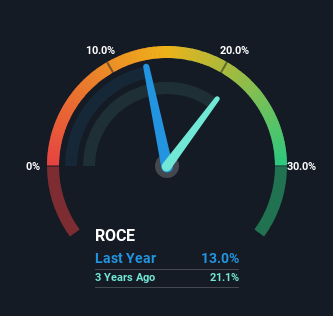Be Wary Of N R Agarwal Industries (NSE:NRAIL) And Its Returns On Capital
Finding a business that has the potential to grow substantially is not easy, but it is possible if we look at a few key financial metrics. Firstly, we'd want to identify a growing return on capital employed (ROCE) and then alongside that, an ever-increasing base of capital employed. This shows us that it's a compounding machine, able to continually reinvest its earnings back into the business and generate higher returns. However, after investigating N R Agarwal Industries (NSE:NRAIL), we don't think it's current trends fit the mold of a multi-bagger.
What Is Return On Capital Employed (ROCE)?
If you haven't worked with ROCE before, it measures the 'return' (pre-tax profit) a company generates from capital employed in its business. To calculate this metric for N R Agarwal Industries, this is the formula:
Return on Capital Employed = Earnings Before Interest and Tax (EBIT) ÷ (Total Assets - Current Liabilities)
0.13 = ₹1.5b ÷ (₹14b - ₹2.1b) (Based on the trailing twelve months to December 2023).
Thus, N R Agarwal Industries has an ROCE of 13%. That's a pretty standard return and it's in line with the industry average of 13%.
See our latest analysis for N R Agarwal Industries

Historical performance is a great place to start when researching a stock so above you can see the gauge for N R Agarwal Industries' ROCE against it's prior returns. If you want to delve into the historical earnings , check out these free graphs detailing revenue and cash flow performance of N R Agarwal Industries.
What The Trend Of ROCE Can Tell Us
In terms of N R Agarwal Industries' historical ROCE movements, the trend isn't fantastic. Over the last five years, returns on capital have decreased to 13% from 31% five years ago. And considering revenue has dropped while employing more capital, we'd be cautious. If this were to continue, you might be looking at a company that is trying to reinvest for growth but is actually losing market share since sales haven't increased.
On a side note, N R Agarwal Industries has done well to pay down its current liabilities to 16% of total assets. That could partly explain why the ROCE has dropped. Effectively this means their suppliers or short-term creditors are funding less of the business, which reduces some elements of risk. Since the business is basically funding more of its operations with it's own money, you could argue this has made the business less efficient at generating ROCE.
What We Can Learn From N R Agarwal Industries' ROCE
From the above analysis, we find it rather worrisome that returns on capital and sales for N R Agarwal Industries have fallen, meanwhile the business is employing more capital than it was five years ago. Yet despite these concerning fundamentals, the stock has performed strongly with a 48% return over the last five years, so investors appear very optimistic. Regardless, we don't feel too comfortable with the fundamentals so we'd be steering clear of this stock for now.
On a separate note, we've found 2 warning signs for N R Agarwal Industries you'll probably want to know about.
For those who like to invest in solid companies, check out this free list of companies with solid balance sheets and high returns on equity.
Valuation is complex, but we're here to simplify it.
Discover if N R Agarwal Industries might be undervalued or overvalued with our detailed analysis, featuring fair value estimates, potential risks, dividends, insider trades, and its financial condition.
Access Free AnalysisHave feedback on this article? Concerned about the content? Get in touch with us directly. Alternatively, email editorial-team (at) simplywallst.com.
This article by Simply Wall St is general in nature. We provide commentary based on historical data and analyst forecasts only using an unbiased methodology and our articles are not intended to be financial advice. It does not constitute a recommendation to buy or sell any stock, and does not take account of your objectives, or your financial situation. We aim to bring you long-term focused analysis driven by fundamental data. Note that our analysis may not factor in the latest price-sensitive company announcements or qualitative material. Simply Wall St has no position in any stocks mentioned.
About NSEI:NRAIL
N R Agarwal Industries
Manufactures and sells finished paper products in India.
Medium-low risk unattractive dividend payer.
Similar Companies
Market Insights
Community Narratives



